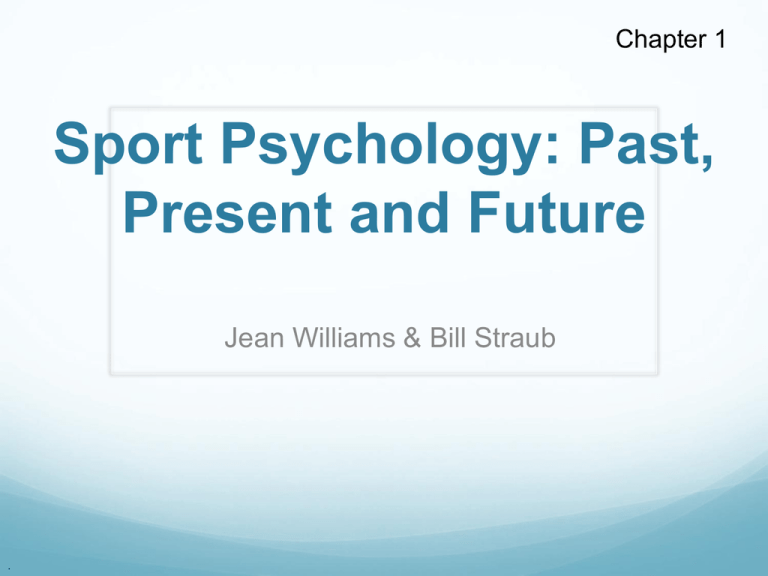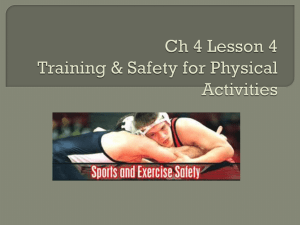Sport Psychology:
advertisement

Chapter 1 Sport Psychology: Past, Present and Future Jean Williams & Bill Straub . Focus of Applied Sport Psychology 1. Understand psychological factors that influence participation and exercise performance in sport and 2. Understand psychological effects derived from participation and performance 3. Identify interventions to enhance performance, participation, and personal growth . Sport Psychologists Study Motivation Personality Violence Leadership Group Dynamics Exercise and psychological well-being Thoughts and feelings of athletes Many other dimensions of participation in sport and exercise . What Sport Psychologists Do Teach . Research Consulting Applied Sport Psychologists Asks questions such as how to: . Manage competitive stress Control concentration Improve confidence Increase communication skills and team harmony Maintain optimal motivation Deal with burnout and injury Enhance coaching effectiveness Increase exercise participation Broad Goals of Psychological Skills Training To learn to consistently create the ideal mental climate that unleashes those physical skills that allow athletes to perform at their best To use interventions to enhance physical and mental health by increasing exercise participation . History of Sport Psychology in North America Roots lie in Greek antiquity, but scientific foundation comes primarily from last 40 years Coleman Griffith an exception –active 1920’s to 1930’s – Hired by University of Illinois to help coaches performance, first SP laboratory and course – Wrote Psychology of Coaching (1926) and Psychology of Athletics (1928) plus 40 articles Dorothy Yates an exception –active during 1930s-1950s - Wrote 2 books describing her mental training interventions with boxers and aviators - Taught psychology course at San Jose State for aviators and athletes . 1965-1979 Birth of applied sport psychology (e.g., Bruce Ogilvie and Tom Tutko) Clinical Psychologists (San Jose State Univ.) Extensive personality testing and team consulting, wrote Problem Athletes and How to Handle Them (1966) Bruce Ogilvie often referred to as the father of applied sport psychology in North America Formation of first sport psychology professional organizations Father of Sport Psychology In Canada – Terry Orlick . SP Professional Organizations International Society of Sport Psychology (ISSP, 1965) North American Society for the Psychology of Sport and Physical Activity (NASPSPA, 1967) Canadian Society for Psychomotor Learning and Sport Psychology (SCAPPS, 1969) European Federation of Sport Psychology (FEPSAC, 1969) Mental Training Registry (1980) Association for Applied Sport Psychology (AASP,1985) (“the Advancement of” in title prior to 2006) American Psychological Association (APA) Division 47 (1987) Canadian Sport Psychology Association (2008?) Canadian Sport Psychology Association (Division ?) . The 1970s Primary goal: Advance knowledge base through experimental research Topics diverse and many target populations Increased cognitive focus: attention to athletes’ thoughts and images Interactionism paradigm (considers person, environmental variables, and their interaction) surfaced and gained credibility Performance enhancement consulting discouraged due to lack of knowledge base . 1980s Cognitive focus continued, plus emphasis on field versus lab research Growth in exercise and health psychology issues and research Extensive documentation of the effectiveness of psychological interventions advocating performance consulting – led to Recognition and use of sport psychology consultants by the USOC and its athletes Mental Training Registry establish (Canada) Growing practice concerns led to addressing professional issues Formation of AAASP (1985, became AASP in 2006) and APA Division 47 (1987) . Sport Psychology Journals International Journal of Sport Psychology (1970) Journal of Sport Psychology (1979) changed to Journal of Sport and Exercise Psychology (1988) The Sport Psychologist (1987) Journal of Applied Sport Psychology (1989) Psychology of Sport and Exercise (2000) International Journal of Sport and Exercise Psychology (2003) Journal of Clinical Sport Psychology (2007) . 1990-2009 Summary . • Extensive growth and diversification in research and practice • Increase in journals and applied books • Considerable progress regarding professional issues • Growth in job opportunities • AASP establishes standards for certifying consultants (1991) and for an ethical code of behavior (1994, 1996) • Mental Training Registry becomes renamed as Canadian Sport Psychology Association 1990-2009 Research Growth documenting effectiveness of interventions to enhance performance and personal growth More emphasis on health and exercise psychology issues, including interventions to increase physical activity Emerging diversity in methods, paradigms, and epistemology e.g., feminist epistemology, influence of culture, singlesubject designs, qualitative methods . 1990-2014 Job Opportunities Growth in consulting job market All ages and skill level, NCAA athletic departments, fitness industry, sports medicine, performance enhancement in non-sport populations (e.g., Army Centers for Enhanced Performance) Growth in academic job market Most in sport science but some in psychology Growth in exercise psychology positions Partly driven by greater external research funding . Some Homework Summarize how you become certified mental training consultant in Canada? In the United States? What are the key organizations to belong to as a consultant? In Canada? In the United States? . Two Governing Bodies in Canada - CSPA Canada Sport Psychology Association Canadian Sport Psychology Association Training – psychology Training – educational emphasis with some kinesiology /kinesiology emphasis with some psychology Title: Sport Psychologist Title: Mental Performance Consultant . AASP Certification Criteria Masters or doctoral degree in related field (e.g., sport science, psychology) Coursework 12 categories (11 require equivalent of one 3-unit course, SP category requires 3 courses) 4 can be undergraduate, unless stated otherwise Supervised practicum 700 hrs masters 400 hrs doctoral Once certified, have recertification requirements . AASP Certification Coursework Categories C1: Professional ethics and standards One ethics course or several with ethics content C2: Sport psychology Three 3-unit courses (1 can be independent study, 2 grad) C3: Biomechanical and/or physiological bases of sport e.g., biomechanics, kinesiology, exercise physiology C4: Historical, philosophical, social, or motor behavior bases of sport e.g., motor learning/control, motor development, sport sociology, history or philosophy of sport . AASP Certification Coursework Categories (cont.) C5: Psychopathology and its assessment e.g., abnormal psychology, psychopathology C6: Counseling skills (graduate level) e.g., interventions or practice in counseling, clinical psychology C7: Skills/techniques/analysis within sport/exercise e.g., sport skills/technique/coaching courses, clinics, coaching experience, participation in organized sport C8: Research design, statistics, and psychological assessment (graduate level) C9: Biological bases of behavior e.g., comparative psych, neuropsychology, physiological psych, sensation, psychopharmacology, exercise physiology, biomechanics/kinesiology . AAASP Certification Coursework Categories (cont.) C10: Cognitive-affective bases of behavior e.g., cognition, emotion, learning, memory, motivation, motor learning, motor development, perception, thinking C11: Social bases of behavior e.g., cultural, ethnic, group processes, gender roles, social psychology, organizational/systems theory, sport sociology C12: Individual behavior e.g., developmental psychology, health psychology, individual differences, personality, exercise behavior Note: Categories 9-12, only 2 of 4 can be sport based . AAASP versus CSPA What is the difference in training between AAASP and CSPA What Courses need to be taken? Masters? Phd? Required? How many supervised hours? . History of Sport Psychology in Eastern Europe Considerable attention given to the applied aspects of sport psychology Specifically, to enhance elite athletes’ performance through applied research and direct intervention Sport psychology was a highly esteemed field of academic and professional concern within national sport . History of Sport Psychology in Eastern Europe (cont.) Self-regulation training Voluntarily control such bodily functions as Heart rate Temperature Muscle tension Emotional reactions to stressful situations Autogenic training, visualization, and autoconditioning (self-hypnosis) were key methods used by Eastern European sport psychologists . Future Directions in North American Applied Sport Psychology Vealey suggests more inclusive and diverse research questions and methods Need greater specialization in training of future students due to growth in knowledge base Promote more career opportunities for future sport psychologists More emphasis on positive psychology Seeks to understand positive emotion and build one’s strength .





